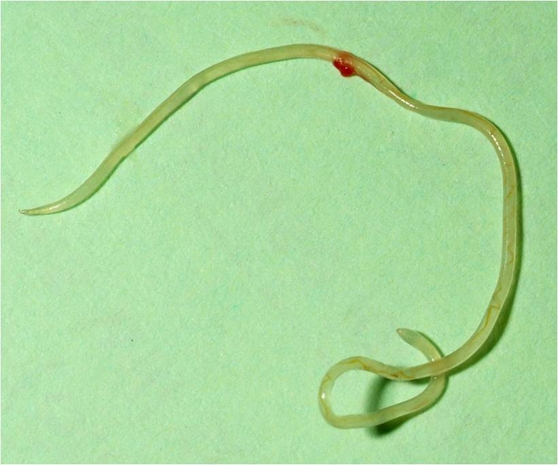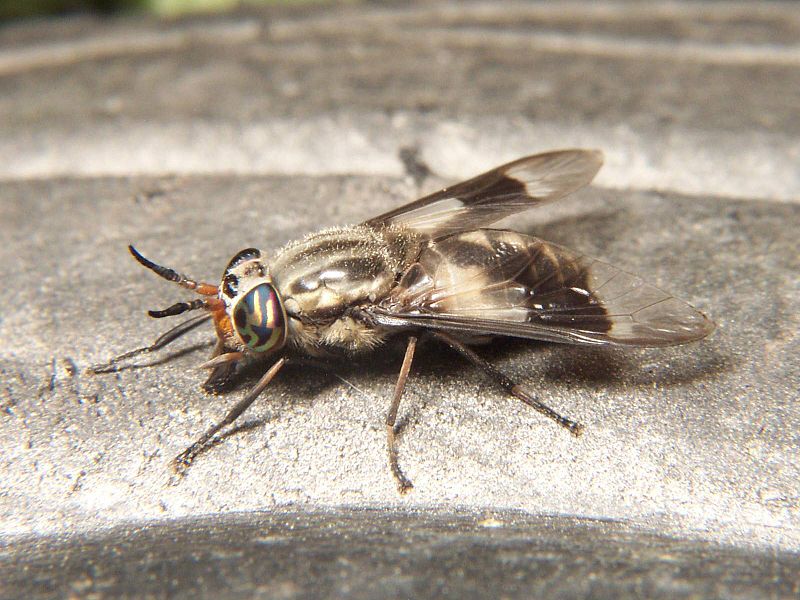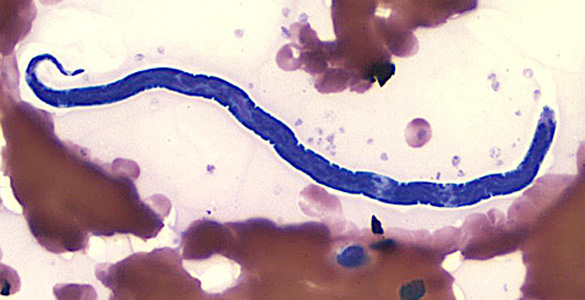Morphology
Morphology of Adult Loa loa worms
 The
morphology of adult Loa loa male and females is very
different from one another. What is unique about the different sexes of
these worms is that the males are significantly smaller than
females and grow at much faster rates (Eberhard and Orihel
1981). Adult male worms range from about 2 cm to 3.5 cm in
length while female worms range from about 2 cm to 7 cm in
length (Roberts and Janovy 2000). The diameter of both
male and female worms is
about 0.035 cm to 0.045 cm, males measuring closer to 0.035 cm and
females closer to 0.045 cm (Roberts and Janovy 2000). A few centimeters may not seem
very large at first, but when you compare this worm to the human
eye which is about 2.5 cm in diameter you can really begin to
understand just how large these worms are in comparison to the
eyeballs and other tissues that they call home.
The
morphology of adult Loa loa male and females is very
different from one another. What is unique about the different sexes of
these worms is that the males are significantly smaller than
females and grow at much faster rates (Eberhard and Orihel
1981). Adult male worms range from about 2 cm to 3.5 cm in
length while female worms range from about 2 cm to 7 cm in
length (Roberts and Janovy 2000). The diameter of both
male and female worms is
about 0.035 cm to 0.045 cm, males measuring closer to 0.035 cm and
females closer to 0.045 cm (Roberts and Janovy 2000). A few centimeters may not seem
very large at first, but when you compare this worm to the human
eye which is about 2.5 cm in diameter you can really begin to
understand just how large these worms are in comparison to the
eyeballs and other tissues that they call home.
Morphology of Microfilariae
Microfilariae are extremely small
ranging from 250-300 μm long by 6-8 μm in diameter. These
young worms develop through three larval stages during their
life as microfilariae.
 During their first larval stage, microfilariae eggs are protected by sheath coverings. They
shed these sheath coverings when they are transferred from the
body fluid of their mammalian host to
the mouth of their
arthropod host and travel to the fly's mid-gut where they develop into their second larval stage
(Eberhard and Orihel 1981). In the third stage,
microfilariae migrate
back up to the mouth of the fly where they wait to be
transferred to their mammalian host (Eberhard and Orihel 1981).
During their first larval stage, microfilariae eggs are protected by sheath coverings. They
shed these sheath coverings when they are transferred from the
body fluid of their mammalian host to
the mouth of their
arthropod host and travel to the fly's mid-gut where they develop into their second larval stage
(Eberhard and Orihel 1981). In the third stage,
microfilariae migrate
back up to the mouth of the fly where they wait to be
transferred to their mammalian host (Eberhard and Orihel 1981).
 How does Loa loa move about
its hosts?
How does Loa loa move about
its hosts?
Loa loa does the
most of its traveling while in the form of microfilaria and
involves the use of two hosts: a Chrysops fly and a mammal. If
you are interested in learning more about these hosts, check out
the life cycle of Loa loa on our
REPRODUCTION page
or take a look at how Loa loa interacts with its hosts on
our INTERACTIONS page!
When a Chrysops fly bites an infected mammal, microfilariae is transferred
through the mammal’s blood to the fly. Once the infected
fly feeds on a new mammal, the third stage microfilariae larva is
transferred into the mammal’s blood stream. It uses the
circulatory system to
migrate to the subcutaneous tissue of
 the mammal’s body, most
notably the eye (Roberts and Janovy 2000).
Adult Loa loa will grow and develop in the subcutaneous
tissues and usually remain there the rest of their lives which
can be up to 17 years! A small percentage of worms migrate from
subcutaneous tissues to other organs in the body through
lymphatic system (Roberts and Janovy 2000).
When adult Loa loa mate and produce new microfilariae,
these new eggs "hop aboard" the blood stream and either remain
there or travel to other bodily fluids such as spinal fluid, or
urine, where they await the bite of a Chrysops fly
(Roberts and Janovy 2000). Studies have shown that microfilariae
express diurnal periodicity.
the mammal’s body, most
notably the eye (Roberts and Janovy 2000).
Adult Loa loa will grow and develop in the subcutaneous
tissues and usually remain there the rest of their lives which
can be up to 17 years! A small percentage of worms migrate from
subcutaneous tissues to other organs in the body through
lymphatic system (Roberts and Janovy 2000).
When adult Loa loa mate and produce new microfilariae,
these new eggs "hop aboard" the blood stream and either remain
there or travel to other bodily fluids such as spinal fluid, or
urine, where they await the bite of a Chrysops fly
(Roberts and Janovy 2000). Studies have shown that microfilariae
express diurnal periodicity.
 Well
you may be asking, “What in the world is diurnal periodicity?”
This is just a fancy biological term which means that
microfilaria live in the blood stream primarily during the day,
while very few
live there during night (Tyagi et al.
2011).
Well
you may be asking, “What in the world is diurnal periodicity?”
This is just a fancy biological term which means that
microfilaria live in the blood stream primarily during the day,
while very few
live there during night (Tyagi et al.
2011).
Other interesting
adaptations of Loa loa
A unique characteristic Loa loa
express that differs from others in their family is that their
body nuclei are located in the tip of the tail and are clumped
together in a row with minimal
 spacing between them. It
has also been found that Loa loa do not have an immune
system that is specific to their species. In fact, they really do not have their own immune system at all. Research has
found that Loa loa has actually adapted in a way that
their immune systems mimic that of their hosts (Desjardins et
al. 2013).
spacing between them. It
has also been found that Loa loa do not have an immune
system that is specific to their species. In fact, they really do not have their own immune system at all. Research has
found that Loa loa has actually adapted in a way that
their immune systems mimic that of their hosts (Desjardins et
al. 2013).
If you would like to
learn more about the reproduction of Loa loa check out
our REPRODUCTION page!
Return to HOME

Return to HOME